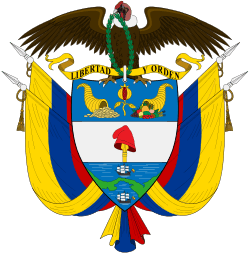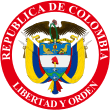President of Colombia
| President of Colombia
Presidente de Colombia | |
|---|---|
|
Presidential Standard | |
|
Presidential Seal | |
| Residence | Casa de Nariño |
| Term length | Four years |
| Inaugural holder | Simón Bolívar |
| Formation | 17 December 1819 |
| Salary | $23.460.630 ($13,000 USD) |
| Website | The Presidency |
 |
| This article is part of a series on the politics and government of Colombia |
| Constitution |
|
Legislature |
|
Executive
|
|
|
Major political parties
|
|
Related topics
|
|
Politics portal |
The President of Colombia (Spanish: Presidente de Colombia) is the head of state and head of government of Colombia. The office of president was established upon the ratification of the Constitution of 1819, by the Congress of Angostura, convened in December 1819, when Colombia was part of "la Gran Colombia". The first president, General Simón Bolívar,[1] took office in 1819. His position, initially self-proclaimed, was subsequently ratified by Congress.
The current president of the Republic of Colombia is Juan Manuel Santos, who took office on 7 August 2010.
Functions
According to the Colombian Constitution of 1991, Article 188: The President of Colombia is the head of state, head of government and Supreme Administrative Authority. The President of Colombia symbolizes the National Unity and after taking an oath to the Constitution of Colombia and swearing to defend and protect the nation's laws, he is charged to guarantee and protect the Rights and Liberties of all the Colombian nationals.
The Administrative Department of the Presidency of Colombia has the commission to assist or support the President of Colombia on its constitutional mandated functions and legal issues.
Colombian Constitution of 1991 Article 115: States that the National Government is formed by the President of Colombia, the Vice President of Colombia, the Council of Ministers of the Republic of Colombia and the Directors of the Administrative Departments of Colombia. Any official from these entities constitute the Government of Colombia in any particular business.
Any act by the President of Colombia, in order to be legal and enforceable, must be sanctioned by any of the ministries or department directors, who will also be held responsible for the act. The only exception is if the President appoints or removes minister, administrative departments' directors and any other officials appointed by him under his administrative authority. Governors of the Departments of Colombia, Mayors of Municipalities of Colombia, as well as regional Superintendents of Colombia, public establishments and industrial and commercial state owned enterprises, are all part of the Executive branch of Colombia.
General description
The Colombian Constitution of 1991, coupled with several articles of amendment, establishes the requirements an eligible candidate must meet in order to become president, as well as the term of office, method of election, and powers.
Requirements for holding
Colombian Constitution of 1991 Article 191: states that the president must be a natural born citizen of Colombia and at least 30 years of age.
Term of office and election
The president and vice president serve a term of office of four years after being elected by popular vote. Reelection in Colombia was not allowed until 24 November 2005 when the Colombian Congress approved it by introducing the Electoral Guarantees Law (Ley de Garantias Electorales) which modified Article 152, of the Colombian Constitution of 1991. The President or Vice President desiring a reelection must officially postulate its candidacy in the National Electoral Council and guarantee a fair competition for the other contenders, because of this, participation of acting officials in political proselytism was standardized. If the president or vice president are not running for office they are prohibited from participating on political proselytism. If one or both are participating, he/she is authorized to participate in these activities four months prior to the primary elections. Also, if the president and/or vice president are running for office they will also be authorized to participate in their political party's selection mechanism to postulate candidates.
In 2010, the Constitutional Court of Colombia threw out a planned referendum to allow presidents to run for three consecutive terms. It ruled that Colombian presidents cannot serve three terms, even if they are nonconsecutive.
Last election
| Candidates – Parties | First round | Second round | ||
|---|---|---|---|---|
| Votes | % | Votes | % | |
| Juan Manuel Santos – Social Party of National Unity (Partido de «la U») | 3,301,815 | 25.69 | 7,816,986 | 50.95 |
| Óscar Iván Zuluaga - Democratic Center (Centro Democrático) | 3,759,971 | 29.25 | 6,905,001 | 45.00 |
| Marta Lucía Ramírez – Colombian Conservative Party (Partido Conservador Colombiano) | 1,995,698 | 15.52 | ||
| Clara López Obregón – Alternative Democratic Pole (Polo Democrático Alternativo) | 1,958,414 | 15.23 | ||
| Enrique Peñalosa - Colombian Green Party (Partido Verde Colombiano) | 1,065,142 | 8.28 | ||
| Total votes for candidates | 12,081,040 | 94.01 | 14,721,526 | 95.96 |
| Blank votes | 770,610 | 5.99 | 619,396 | 4.03 |
| Total valid votes | 12,851,650 | 97.24 | 15,341,383 | 97.12 |
| Null votes | 311,758 | 2.35 | 403,405 | 2.55 |
| Unmarked ballots | 52,994 | 0.40 | 50,152 | 0.31 |
| Turnout | 13,216,402 | 40.07% | 15,794,940 | 47.89% |
| Source: Registraduría Nacional del Estado Civil, Registraduría Nacional del Estado Civil | ||||
See also
- List of Presidents of Colombia
- Vice President of Colombia
- Council of Ministers of the Republic of Colombia
- Politics of Colombia
References
- ↑ Gobernantes Colombianos, Ignacio Arismendi Posada, Interprint Editors Ltd., Italgraf, Segunda Edición, Page 15, Bogotá, Colombia, 1983
External links
- Presidencia de la Republica de Colombia (Spanish)
- Georgetown University - Requisites to be President of Colombia
- Presidencia de Colombia - Ley de Garantias Electorales
| ||||||||||||||||||||||||
| ||||||||||
| ||||||||||


